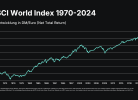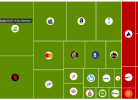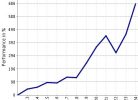By MITCH ZACKS
There’s no sugar coating it – 2020 was a tough year. The country confronted a once-in-a-generation pandemic, a major service-sector driven recession, a divisive and contentious election cycle, and social tensions of many different stripes. Multiple issues seemed to collide all at once.
I won’t weigh-in on social or political issues here, but from an economic perspective, I can confidently say the U.S. is primed for a strong recovery in 2021. Here are four reasons I think you should be hopeful – and bullish – in 2021.
Reason #1: Don’t Fight Excess Liquidity
The Federal Reserve’s monetary response to the pandemic-fueled recession happened in record time and in record dollar amounts. The Federal government followed suit with the CARES Act, injecting trillions more into the U.S. economy. In all, 2020’s monetized stimulus amounted to more than 15% of GDP – an astounding number.
Not all of that liquidity has flowed through the capital markets yet, and more is on the way. I realize that recent fiscal stimulus talks have stalled and resulted in impasse after impasse. But I remain confident that another package is in the future, and I think it could amount to another $1 trillion in spending.
A structural budget deficit in 2021 seems all but assured, which I view as a major positive for the private sector and ultimately, stocks. The Federal Reserve also looms in the backdrop with unwavering monetary stimulus.
Reason #2: Cash Reserves + Pent-Up Demand = Spending
A common reflex in an economic crisis is to build-up cash reserves. The Covid-19 pandemic was no exception for many American households.
In early December, personal savings were $1.3 trillion higher than the pre-pandemic trend suggested they would be – a result of households socking away cash and not being able to spend through normal channels due to travel and other economic restrictions. The $1.3 trillion that households have in savings amounts to over 6% of GDP, and I think that money is eager to be spent. A post-pandemic economy could feel this wave of pent-up consumption demand.2
Corporations have also been building cash reserves, with many taking advantage of low rates to issue bonds. The Federal government is even holding historically high levels of cash, having $1.7 trillion stashed in the U.S. Treasury’s General Account. This liquidity is not likely to stay dormant in savings, in my view.
Reason #3: Technological Innovation That’s Profitable
Technology’s role in economic development has been a persistent theme over the last 20-30 years. But the critical difference between now and 20-30 years ago is that the technology companies leading the way are generating significant cash flows. That’s key.
They’re also generating significant cash flows in record time. Instead of spending years and massive amounts of capital to build a network of plants or stores, they can sell a product or a service over the internet, or via a smartphone. The “asset-light” technology companies of today can spend their resources and profit reaching new customers, instead of maintaining and growing capital assets.
2020 saw rapid-fire adoption of many new technology services and ways of shopping, from businesses implementing new digital infrastructure, to retailers rolling out e-commerce channels, to consumers trying services like grocery delivery for the first time. These technological trends were underway already, but 2020 served as a catalyst propelling them forward. I expect the momentum to continue in the new year.
Reason #4: Low Interest Rates Aren’t Going Anywhere, and Investors Know It
The reality of lower-for-longer interest rates is generally bad news for savers, but generally good news for equity investors and borrowers. I have written before that interest rates anchored to the zero bound tend to push investors further out onto the risk curve, particularly those in search of yield. What assets are out on the risk curve ready to receive this rotating capital? Stocks, in my view.
The short-to-medium term outlook for low/negative real bond yields pushes down the discount rate, making equities attractive relative to bonds. When pricing stocks, a quick method is to consider a corporation’s future earnings potential less the risk-free interest rate – this is the discount rate. A lower discount rate means that future corporate earnings are more valuable, which by extension tends to make stocks more attractive.
If the options are to lose money on Treasuries or to own a portion of a company’s future earnings (by owning shares of stock), investors today are being nudged to choose the latter, in my view.
Furthermore, the free cash flow yield on the S&P 500 is a staggering 10 times the yield available on the 2-Year U.S. Treasury. I’d much rather invest in the former.
Bottom Line for Investors
All of my arguments above centered on economic fundamentals and projections, without any mention of the vaccine! The ‘herd immunity’ we can achieve from vaccine uptake is perhaps the biggest story of 2021, and one I think most Americans are ready to embrace.
I understand that many Americans will not want to take the vaccine, and that the rollout is complex and could get messy. But I strongly believe there is light at the end of this tunnel, and society can return to normal in the second half of next year. I’m excited to see what that looks like for the economy, and thinking about it makes me very bullish.
Wenn du keinen Beitrag mehr verpassen willst, dann bestell doch einfach den Newsletter! So wirst du jedes Mal informiert, wenn ein neuer Beitrag erscheint!








„ This liquidity is not likely to stay dormant in savings, in my view“
Siehst du nach Ende der Pandemie eine Inflation oder gar Hyperinflation kommen?
Nein. Warum sollte das passieren? Die Hyperinflation die wir immer alle im Kopf haben (20er Jahre) war das Ergebnis des Ersten Weltkrieges, einer enormen wirtschaftlichen Schwäche Deutschlands, hoher Reparationen und eines hinzukommenden Gelddruckens. Das war am langen Ende ein (verschleppter) Staatsbankrott. In Österreich ebenso. Wir haben nach 2008 keine Inflation bekommen und derzeit ist nicht zu erkennen wo sie jetzt herkommen sollte.
Auch hohe Inflation ist kein Spaß. Ich kann mich noch gut an die 70er Jahre erinnern. In den USA schossen die Zinsen auf 16 Prozent. Aber auch da war nicht die Ausweitung der Geldmenge durch die Notenbanken der Grund (soweit ich das verstehe).
Letzter Punkt: Warum beschäftigen sich so viele Menschen mit dem, was vielleicht passieren könnte. Die Liste möglicher Probleme ist unendlich lang. Nur wenige dieser möglichen Probleme machen Anlegerinnen und Anlegern dann auch tatsächlich Sorgen (von einem Krieg zwischen Pakistan und Indien sorgt sich seltsamerweise schlicht niemand – obwohl er einer der größten realen Gefahren ist). Sich vor möglichen Problemen zu sorgen war schon im vergangenen (an Problemen wirklich reichen) Jahrhundert keine gute Idee. Es hat die Menschen davon abgehalten, ihr Geld einfach in den Markt zu tun – und abzuwarten. Der Return: 10 Prozent pro Jahr und immer noch 6,5 Prozent wenn wir die Inflation abziehen.
Menschen machen sich ganz offensichtlich sehr gerne Sorgen. Das ergibt keinen Sinn. Was einen Sinn ergibt, das ist Vorsicht. Die Vorsicht gebietet, kein Geld in den Markt zu tun, dass du in den nächsten 5 Jahren brauchst. Die Vorsicht gebietet aber noch ein zweites: Geh immer davon aus, dass das schlimmste was der Markt in den vergangenen 100 Jahren gemacht hat (10 Jahre ohne jeden positiven Return – selbst dann, wenn man die Dividenden mitrechnet) auch in den nächsten zehn Jahren passieren kann. Niemand weiß wann es passiert – aber es wird eins Tages mit einer sehr hohen Wahrscheinlichkeit wieder so kommen. Auch dann ist allerdings Nachkaufen die beste Strategie. Wenn Aktien günstig sind.